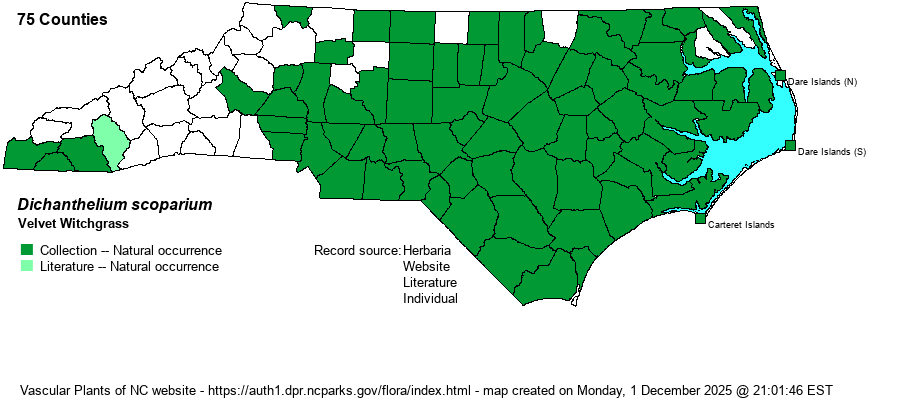| Author | (Lamarck) Gould | |
| Distribution | Outer Banks, Coastal Plain, Sandhills, and Piedmont; several records in the low Mountains.
MA to MI south to FL and TX; Mex., W.I. | |
| Abundance | Common throughout, except in the upper Piedmont and Mountains, where rare to uncommon. | |
| Habitat | Moist to seasonally wet savannas, flatwoods, streamhead ecotones, maritime wet grasslands, openings in swamp forests, wet meadows or pastures, roadside ditches, damp powerlines. Partial to disturbance, such as roadside runoff sand, scrapes, etc. |
| Phenology | Flowering and fruiting May-October. | |
| Identification | Well-named, the dense, white, and velvety pubescence on the stems, leaves, and leaf sheaths, coupled with the plant's large size, is unique. The stems typically reach 2-4 feet tall, with leaf blades 10-20 mm wide. | |
| Taxonomic Comments | None, other than named as Panicum scoparium in older references.
A note about Dichanthelium: This genus is not impossible to identify to species! But it takes applied effort over a period of time in order to learn the various species and what their morphological limits are. We strongly recommend that you read the introduction to the treatment in Weakley et al. (2023), written by Richard LeBlond. LeBlond has made order out of near chaos, and his keys work very well for our plants. Most Dichanthelium taxa ("Dichs") do not grow everywhere indiscrimminately, but prefer certain well-defined habitats. Note that most species produce flowers/fruits twice a year -- a vernal period and an autumnal period -- and that measurements of spikelets and achenes are taken from vernal plants. Some species also have a third, or summer, period. In the vernal period there is a single inflorescence at the tip of the stem. In the autumnal period, plants produce elongate branches with bunched (congested) leaves and so look quite different from vernal plants. Inflorescences are produced in leaf axils as well as at the tips of branches. NOTE: Older texts had these species essentially all within the very large genus Panicum. "Dich" species are typically named as "Witchgrass" and Panicum species named as "Panicgrass". | |
| Other Common Name(s) | Velvet Panicum, Velvety Panicgrass, Broom Panicgrass, and a few others | |
| State Rank | S5 | |
| Global Rank | G5 | |
| State Status | | |
| US Status | | |
| USACE-agcp | FACW link |
| USACE-emp | FACW link |

